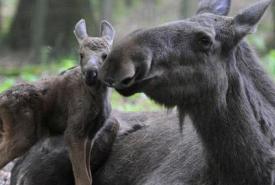Great Lakes mixed forest

Moose and her calf (Photo courtesy of Wild for Wildlife and Nature)
In his 1914 painting, Pine Island, Tom Thomson's bold brush strokes depict trees buffeted by winds on the coasts of Georgian Bay. The branches ark in one direction, shaped by years of rough winds and weather. Thomson's artwork, and that of the larger Group of Seven, are perhaps some of the most iconic representations of Canadian landscapes and forests in our history, including the Great Lakes mixed forest.
The Great Lakes ecoregion is one of the most diverse in Canada and in North America. It is a transitional zone where southern and northern forests meet. This results in a mix of deciduous (such as birch, aspen, maple and oak) and coniferous (such as spruce and pine) tree species. These forests are interspersed with rock barrens, freshwater lakes and wetlands.
What is the ecological significance of this habitat?
This remarkable biodiversity reflects the variations in climate, terrain and altitude of the region in southern Ontario and on the Canadian Shield. In fact, there is a sharper north-south gradient of environmental, climatic and biological change across the Canadian portion of the Great Lakes basin than across any other non-montane (non-mountainous) ecoregion in Canada.
Biologically, the Great Lakes mixed forest includes species representative of the Carolinian, boreal, Arctic, Atlantic and western montane areas, as well as some unique species and subspecies that have evolved as endemics on the shores of the Great Lakes.
What species are found here?
The variety of habitats supports a wealth of biodiversity, including wildlife such as:
- white-tailed deer
- moose
- black bear
- wolf
- pileated woodpecker
- beaver
- many species of birds, fish and insects
What are the threats to this region?
The Great Lakes region has played an integral role in the history and development of Canada. Presently it sustains the core Canadian industrial economy and more than one-quarter of Canada’s population lives here. Nearly 25 percent of the total Canadian agricultural productivity and one of the world’s largest concentrations of energy production are found around the Great Lakes. Development therefore poses increasing pressure on the Great Lakes mixed forest region.
What is NCC doing to protect this habitat?
In 2014, NCC and Kenauk Nature announced a partnership for the conservation of the vast Kenauk property; a great historical and natural treasure. Steeped in Canadian history, the property, which spreads over 260 square kilometres, once belonged to the famous Louis-Joseph Papineau.Kenauk Nature Preserve and is working with partners to conserve habitat within the Great Lakes Mixed forest.
In 2015, 2,025 acres (819 hectares) of forest and significant wetland habitats were protected at the Crane River Tract on the Northern Bruce Peninsula.
A natural partnership
TD Forests is helping to protect forests across Canada.
Learn more about this partnership here >





